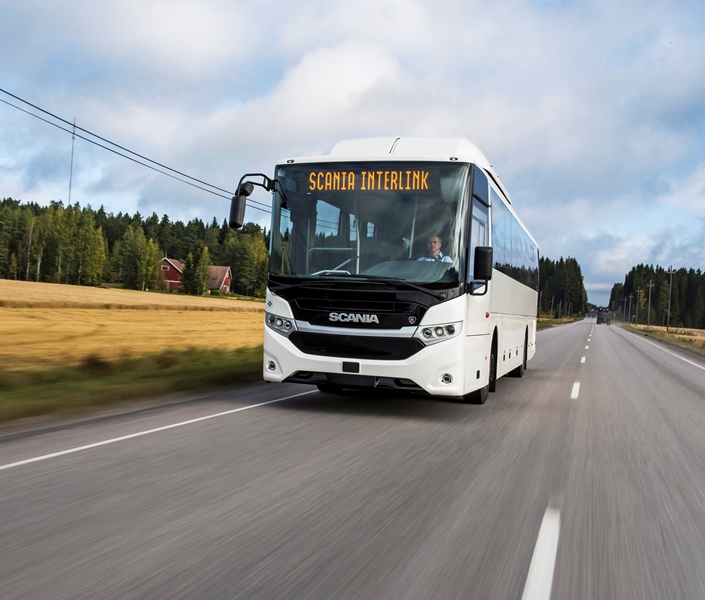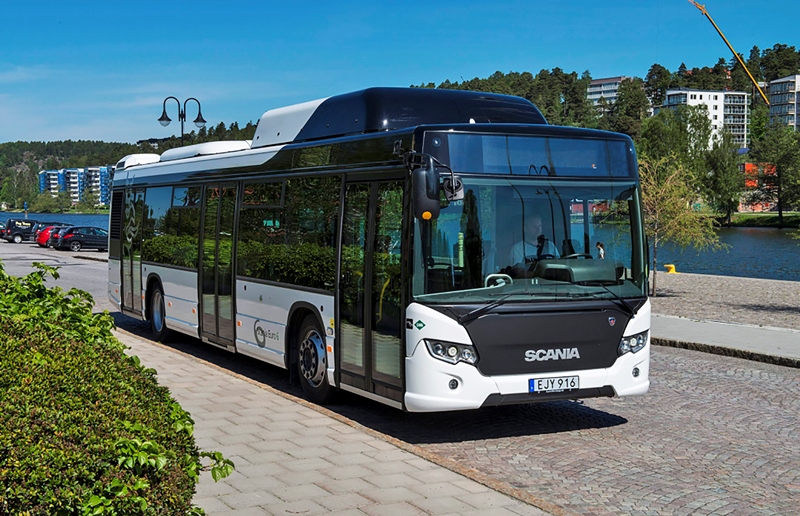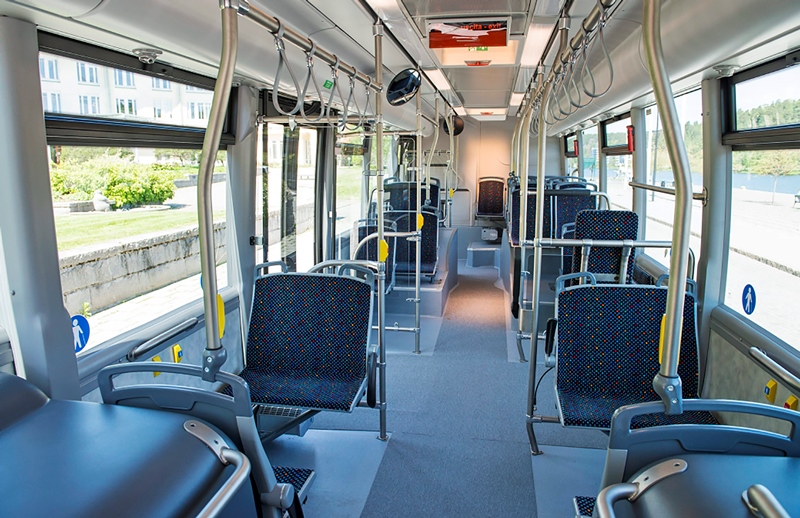Showcases broadest range ever
Scania entered the starting line at Busworld 2015 with its broadest range ever – all with a focus on sustainable solutions. The star of the show at Scania was its new Interlink family of buses for suburban, intercity, express and tourist operations, the most versatile range in the market. The Scania Interlink offers operators unmatched flexibility and customization – different lengths and heights, multiple layouts and the broadest range of fuel options.

“With this new product range we are responding to the varying needs of an operator. Scania Interlink is a true all-rounder offering all the flexibility operators demand without having to compromise”, said Klas Dahlberg, Head of Buses and Coaches at Scania.
The new Scania Interlink family has three members: Low Decker, Medium Decker and High Decker. All feature the unmistakably attractive Scania front and rear styling. The unique angled front, which reduces weight and turning radius, will lower fuel consumption and noise level. The buses are all designed to make the most of interior space for the best passenger capacity in their class and offer the best luggage capacity.
The smart approach behind Scania Interlink is the ability to do many jobs at once –suburb-to-suburb, city-to-city and even countryside-to-countryside. Specially designed for everything, it saves operators the quandary of compromising.
Versatility is Scania’s hallmark. Operators decide on the interior layout and seating of their choice as the basis for deciding on bus length – from 11 to 15 metres with a 2-axle option available up to 13.2 metres. The flexible middle door position helps optimise seat distance and luggage compartment as well as toilet placement.
The range shares a host of common features, facilitating fleet services. Front, rear and roof hatches, seats, rear windows, climate systems, CAN systems, as well as camera and audiovisual systems are only some of the shared features. Additionally, the Medium and High Decker buses have most of the exterior parts in common, focusing on uptime and total cost of ownership.
The Medium and High Decker buses have been further improved with a raised aisle for a lower podester height of 170 mm. Passengers can thereby enjoy a broader interior view, which in combination with the 100 mm lower side window, provides a spacious perspective.
Despite Scania Interlink’s stiffer body, introduced to meet the rollover R 66.02 requirement, and more window area, no additional weight has been added in relation to earlier models. With the increased stiffness, passengers will experience less vibration, lower noise and better comfort.
The Scania Interlink builds on the experience of the successful Scania OmniExpress range, of which more than 1,500 European-built buses and coaches have to date been delivered to customers, ensuring well-tested systems.
The buses are available with a wide range of Scania’s acclaimed 9-litre engines for the Scania Interlink Low Decker and 9- and 13-litre engines for the Medium and High Decker. Scania provides engines for all commercially available fuels, including the widest range of engines for alternative fuels – bioethanol, biodiesel and biogas.
“In short, the Scania Interlink is specially designed for everything and will thereby enhance operator versatility and profitability while offering passengers unmatched comfort,” stated Mr. Dahlberg.
Broadest-ever range
Apart from the new Interlink bus, Scania displayed a hybridized Citywide LE with the 320 hp hybrid biodiesel engine, the Citywide LF with the 280 hp gas engine and the Touring HD with the 450 hp engine. “Scania leads the way towards sustainable transport without compromising on performance, operating economy or passenger appeal. We presently offer the widest choice of alternative fuels, all available here and now and I am confident that these vehicles will meet with success in the market. The time is ripe for a new and exciting approach to bus and coach travel that will attract new groups of passengers,” he added.
The Scania Citywide will be the first ever bus on the market that contains cost saving and emission reducing hybrid technology and meets EU suburban and short distance class II regulations. The new offering is the next step in Scania’s sustainability journey towards providing carbon neutral transport solutions. And it significantly widens the Scania offer to bus and coach operators.

The hybridised Scania Citywide bus, which uses the Euro 6 powertrain and runs on up to 100 percent biodiesel, was launched in 2014. But it could only be used on short distance and suburban operations in markets where there were no specific regulations governing this or if the operators drove under 70 km/h.
A new specification Scania Citywide has now been produced which meets the EU class II suburban and short distant regulations and can therefore be operated within the relevant markets at speeds of up to 100 km/h. It also has higher seats with seat belts as well as roll-over certification, which means that the vehicle meets certain accident regulations.
Mr. Christer Evensson, Head of City and Suburban Segment at Scania said: “We can already see in some of our markets a real expectation for this kind of bus. By adding a Scania Citywide hybrid bus that meets class II regulations, Scania is significantly broadening its offer to bus and coach customers. We are also benefitting the wider society through the provision of lower emission producing and more environmentally friendly vehicles.”
Scania’s hybrid system is part of Scania’s modularised range of powertrains that powers both buses and trucks in an immense range of combinations. It is also part of Scania’s long-term strategy for powertrain electrification for both trucks and buses.
The hybrid powertrain includes the Scania 9-litre engine and offers 320 hp with SCR-only technology that is compatible with up to 100 percent biodiesel and Hydrotreated Vegetable Oil (HVO).
On the Citywide buses, the hybrid unit, comprising an electric machine (motor and generator) and automatic clutch, is located between the engine and gearbox. The electric machine is rated at 150 kW and 1,050 Nm.
1.2 kWh of energy storage is provided by a lithium-ion battery integrated in the roof structure at the front of the bus and is housed in a neatly styled bulb together with a DC/DC voltage converter and a cooling unit.
The use of a Scania hybrid system together with a DC/DC converter, stop-start function and eco-roll provides significant fuel savings. The combined fuel and the use of biodiesel provide CO2 savings of up to 90 percent, a uniquely high figure for Euro 6 hybrid buses.
The hybridized Scania Citywide LE with the 320 hp hybrid biodiesel engine is a 12-metre bus which now also complies with requirements for Class II operations, features an innovative approach to an efficient passenger flow. Designed primarily for suburb-to-suburb and suburb-to-city operations in order to gain the full energy and economic potential of hybridisation, the interior has been planned accordingly. The forward section features ample standing space for passengers travelling short distances while those on longer journey can enjoy comfortable seating.
The other two vehicles at the Scania pavilion were the Citywide LF with a 280 hp gas engine and the Touring HD with a 450 hp engine.
The Citywide LF is a 12-metre bus, seating 21+2 passengers, equipped with Scania’s acclaimed Euro 6 gas engine with 280 hp power, providing opportunities for cities to substantially reduce not only carbon emissions but also urban noise level. The Touring coach with the 13-litre Scania inline 6-cylinder Euro 6 SCR engine has been further optimised for fuel savings. The 13.7-metre coach to be exhibited at Busworld has a seating capacity of 57+1+1.

